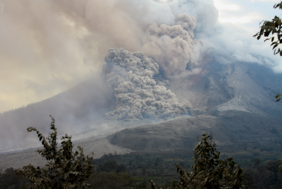Large volcanic eruptions can add sulfur to the atmosphere and cause the formation of sulfate aerosol. If the injection reaches the stratosphere, these particles persist up to a few years and reflect sunlight, acting like a sunshade and cooling the Earth. For example, global surface temperatures decreased by an estimated 0.4°C in the year following the eruption of Mt. Pinatubo on the Philippines in 1991.
However, previous model studies have indicated that a radiative forcing from volcanic aerosol leads to less temperature change than greenhouse gas forcing of the same magnitude. Moritz Günther and colleagues show that this is related to the geographical regions where the temperature change happens.
If the aerosol is mostly concentrated in the tropics, the temperature change is stronger in the Indian and West Pacific oceans than in the global average. Temperature changes in this “warm-pool” region are known to cause stronger negative temperature feedbacks than changes in all other regions of the globe and thereby lead to a relatively weak global temperature response to a given forcing. The warm-pool is special because surface temperature changes in this region are very efficiently communicated to the free troposphere where they can more easily be balanced by radiation to space. Furthermore, stability in the global atmosphere and thereby cloudiness is affected in a way to also cause a more negative feedback. The authors show that this so-called pattern-effect is timescale-dependent: Over tens to hundreds of years, the temperature change maximum moves from the warm pool to other regions, which cuts off the effective balancing of the temperature perturbations by radiative energy transfer to space. However, this timescale is longer than the effect of a volcanic eruption typically lasts, since aerosol in the real world falls out of the stratosphere after a few years. In comparison to the forcing from an increase of atmospheric CO2 the particular pattern-effect caused by stratospheric aerosol leads to the aerosol forcing being less effective. The authors show that such a difference in temperature change patterns is not only simulated in the MPI-ESM but by a majority of CMIP models.
The results highlight the importance of the Indian and West Pacific Ocean in stabilizing the Earth’s climate, and provide an improved understanding of the climate system’s response to perturbations of the stratospheric aerosol layer.
Original publication:
Günther, M., Schmidt, H., Timmreck, C., & Toohey, M. (2022) Climate feedback to stratospheric aerosol forcing: the key role of the pattern effect. Journal of Climate. Early online release, https://doi.org/10.1175/JCLI-D-22-0306.1
Contact:
Moritz Günther
Max Planck Institute for Meteorology
Email: moritz.guenther@mpimet.mpg.de
Dr. Hauke Schmidt
Max Planck Institute for Meteorology
Email: hauke.schmidt@mpimet.mpg.de
Dr. Claudia Timmreck
Max Planck Institute for Meteorology
Email: claudia.timmreck@mpimet.mpg.de


